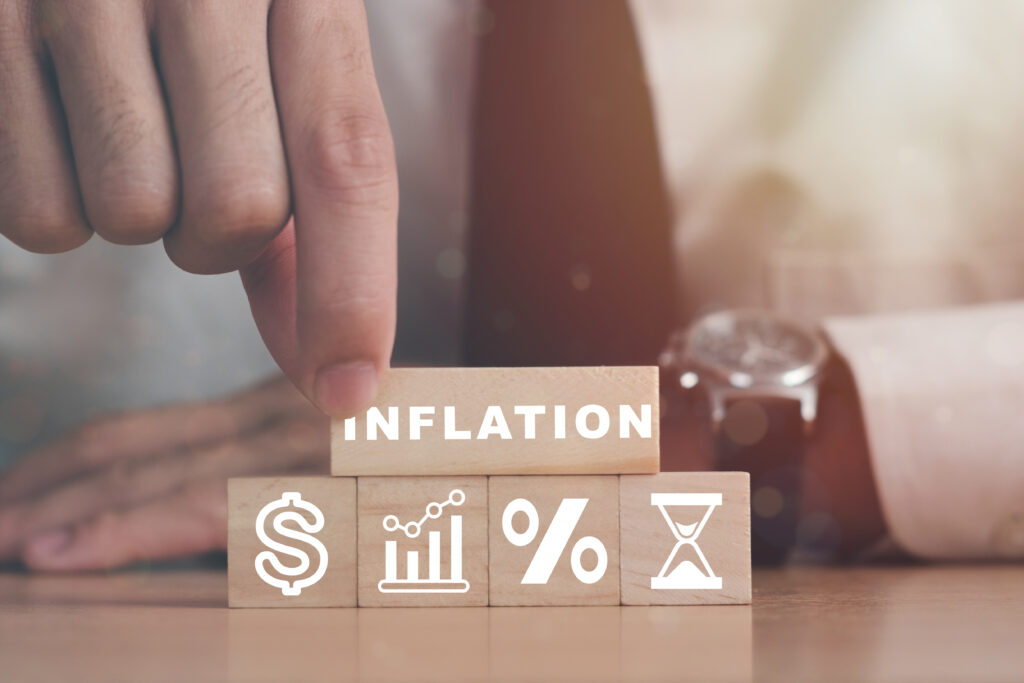
Amidst the uncertainties of a polarised political environment and economic slowdown globally, the cost of living remains as relevant as ever for the man on the street. The rate of inflation is often used as an indicator of price levels and the general cost of living. Interestingly, Singapore experienced a record two year period of negative inflation from November 2014 to October 2016. This article takes a closer look at negative inflation and what its causes were. Is inflation – positive and negative — good or bad for the economy? Is negative inflation the same as deflation? Looking beyond inflation, what is a good gauge for whether we are better off in economic terms over time?
Inflation is Singapore is measured via the Consumer Price Index (CPI), which is compiled by the Department of Statistics and measures headline inflation. In 2015 and 2016, headline inflation came in at an average of -0.5% for each year. It finally bottomed out at 0% in November 2016. Continuing the turnaround, economic agencies expect inflation to pick up to between 0.5% and 1.5% in 2017. The last time Singapore’s headline inflation saw such a long period of contraction was from 1975 to 1977 – an agonising 16 months of declining prices in a global recession.
Drivers of Negative Inflation
Experts have attributed the spell of negative inflation to government intervention in the market and falling global commodity prices. Locally, the major drivers were declines in Singapore’s accommodation and private transport costs following the government’s introduction of cooling measures to the housing and motor vehicle markets in 2013. At the time, measures such as higher interest rates and tighter loan restrictions were introduced to stabilise prices and consumption patterns in these heated markets.
Economists note that the fall in global crude oil prices — 2014 saw oil prices drop 40% — led to a drop in the price of direct oil-related items in the CPI basket such as petrol and electricity. Oil being an input to nearly all economic activity, it follows that a drop in oil prices would lead to a general decline in prices, contributing to negative inflation. Negative inflation has since turned around as oil prices rose from US$30 to $50 from January to December 2016 with early expectations of an improving global economy in 2017, and the initial impact of the government’s cooling measures tapering off.
Understanding Terminology – Headline Inflation, Core Inflation, Negative Inflation, and Deflation
It must be made clear that the fall in the CPI and negative inflation which made headlines refer to headline inflation which is a different measure to core inflation. It is thus important to understand: what the CPI constitutes; what the differences are between headline and core inflation; and what deflation is.
The CPI comprises a fixed basket of goods and services commonly purchased by households and measures their average price changes over time. The CPI basket contains about 6600 brands and varieties of consumption goods and services. It covers only consumption expenditure incurred by resident households and excludes non-consumption expenditure such as loan repayments, income taxes and purchase of assets.
In Singapore, the CPI typically refers to headline inflation. However, the headline number may not be the best measure of consumer demand on an everyday basis. Other measures of inflation can help better reflect price changes and understand the forces behind price pressures.
Core inflation, which reflects the price of daily necessities such as food, healthcare and education, and had actually continued to rise in the past two years, is a better indicator of price trends. Importantly, core inflation excludes the accommodation and private transport costs which are included in headline inflation. As opposed to negative headline inflation, core inflation actually rose about 1% in 2016, and is expected to be between 1% and 2% in 2017.
The spell of negative inflation Singapore experienced should also not be confused with deflation. According to former US Federal Reserve chairman Ben Bernanke deflation refers to: “a general decline in prices, with emphasis on the word “general”. Sector specific price declines are generally not a problem for the economy and do not constitute deflation”. Monetary Authority of Singapore (MAS) Managing Director Ravi Menon explained that Singapore was not facing deflation as price declines were “neither pervasive nor persistent”, exemplified by the rise in core inflation and the price of necessities in the spell of negative inflation. Price declines were mostly confined to the motor vehicle and property markets due to government intervention.
An economy experiencing deflation is Japan, which has been struggling to reverse price declines for 15 years. In a bid to stoke lending and spending, its central bank, the Bank of Japan, even set a negative interest rate of -0.1% on some deposits in January 2016.
Inflation and the ‘Goldilocks Principle’
While prolonged and pervasive price declines signal an economy in deflation, economists consider a certain level of positive inflation to reflect a healthy economy. A manageable level of inflation is desirable for its positive effects on profits, income levels and even debt. Just like Goldilocks’ porridge however, inflation cannot be too low or too high.
Falling or negative inflation levels could be a sign of a weak economy. As an economy slows down, consumers get nervous and spend less, be it on houses, cars, vacations or everyday necessities. This lack of demand places downward pressure on prices, shrinks profit margins, and leads to less job creation and falling wages, resulting in a vicious cycle that slows economic activity.
In contrast, rising inflation can have a positive effect on the economy. Rising prices add to profit margins and give companies added justification or incentive to increase the wages of their employees. This boosts morale, productivity and recruitment levels in the workforce, which has a positive knock-on effect for economic activity.
Inflation and rising wages also have a positive effect of debt, which most individuals take on in the form of education, housing or car loans. For instance, a mortgage benefits from inflation as it has the effect of eroding the real value of the debt amount over time. If one has a debt of $50 000 to be serviced over t a 25 year period, the real value of that $50 000 will shrink in proportion to rising wages over time. In contrast, deflation and falling wages increase the real value of debts over time.
Giving his perspective on the issue, Assistant Professor Woo Jun Jie from the School of Humanities and Social Sciences, NTU and Rajawali Fellow, Harvard Kennedy School said: “While high inflation can result in higher costs to households and higher borrowing rates for businesses in instances where central banks decide to raise interest rates in response, overly-low inflation is often associated with slow growth. This is complicated by the fact that measures to counter inflation can be destabilizing, resulting in bubbles, irrational exuberance and excessively loose money (when central banks over-intervene), or worsening a slow-down (when central bank interventions are insufficient). Ensuring a healthy rate of inflation therefore involves a precarious balancing act by central banks.”
Managing Inflation in Singapore
To ensure inflation stays within a desirable range, the MAS, which oversees Singapore’s monetary policy, monitors and manages the inflation rate by adjusting the strength of the Singapore dollar. Thus, when inflation rises too much, the value of the Singapore dollar is allowed to appreciate to rein in the price rise, and vice versa.
In the current environment of subdued economic growth however, inflationary pressures have been mild. This actually prompted the MAS in April 2016 to ease its monetary policy stance by not allowing the Singapore dollar to appreciate in order to address a weakening growth outlook for a Singapore economy that is trade-dependent and needs a competitive currency for export demand. MAS explained that rather than a policy to depreciate the domestic currency, the change only removed the policy to effect a “modest and gradual appreciation path of the Singapore dollar nominal effective exchange rate”.
Looking beyond Inflation
As much as inflation is a useful indicator of the health of the economy, it is imperative that other indicators are also used to comprehensively gauge if one is better off. Drawing from the earlier mentioned relationship between inflation and wages, real income growth can be one such indicator as it goes beyond nominal income levels and takes into account the effects of inflation on purchasing power. Real income growth can be a better measure of how the cost of living and consumption patterns are changing for the man on the street.
According to the Ministry of Finance Singapore (MOF), real individual wages in Singapore have grown in the past decade. These changes have occurred across the spectrum of wage earners – from 2004 to 2014, the bottom 20% of workers enjoyed real wage growth of 14.8%, while the median group of workers saw 21.4% real wage growth. Compared to the first half of the decade (2004 to 2009), both groups also enjoyed faster real wage growth in the second half of the decade (2009 to 2014). These figures suggest that the man on the street has been better off economically in the last decade after taking price changes into account.
Real income growth should also be considered in the context of a household, which serves as the most meaningful social unit beyond an individual. To that end, real household income growth has seen broad-based growth in incomes over the last decade. For instance, the bottom 20% of households by income saw real income grow by 24.1%. Comparing real household income growth internationally, growth in Singapore has generally exceeded that of countries in the same league. Household income for both the median and bottom 20% of households was observed to have grown significantly faster than most developed countries and other Asian Newly Industrialised Economies (NIE), namely Hong Kong, South Korea and Taiwan.
The turnaround in negative inflation and rising real income growth aside, achieving sustained economic growth that is equitably distributed remains paramount. Assistant Professor Woo pointed out that this requires navigating a currently uncertain political and economic environment where the repercussions of a more insular US economy and slower growth in China are playing out. Other than evaluating cost of living indicators, the man on the street should also look to enhance his employability and productivity to ensure he can adapt to the challenges of rising competition and job restructuring brought on by technological disruptions.




